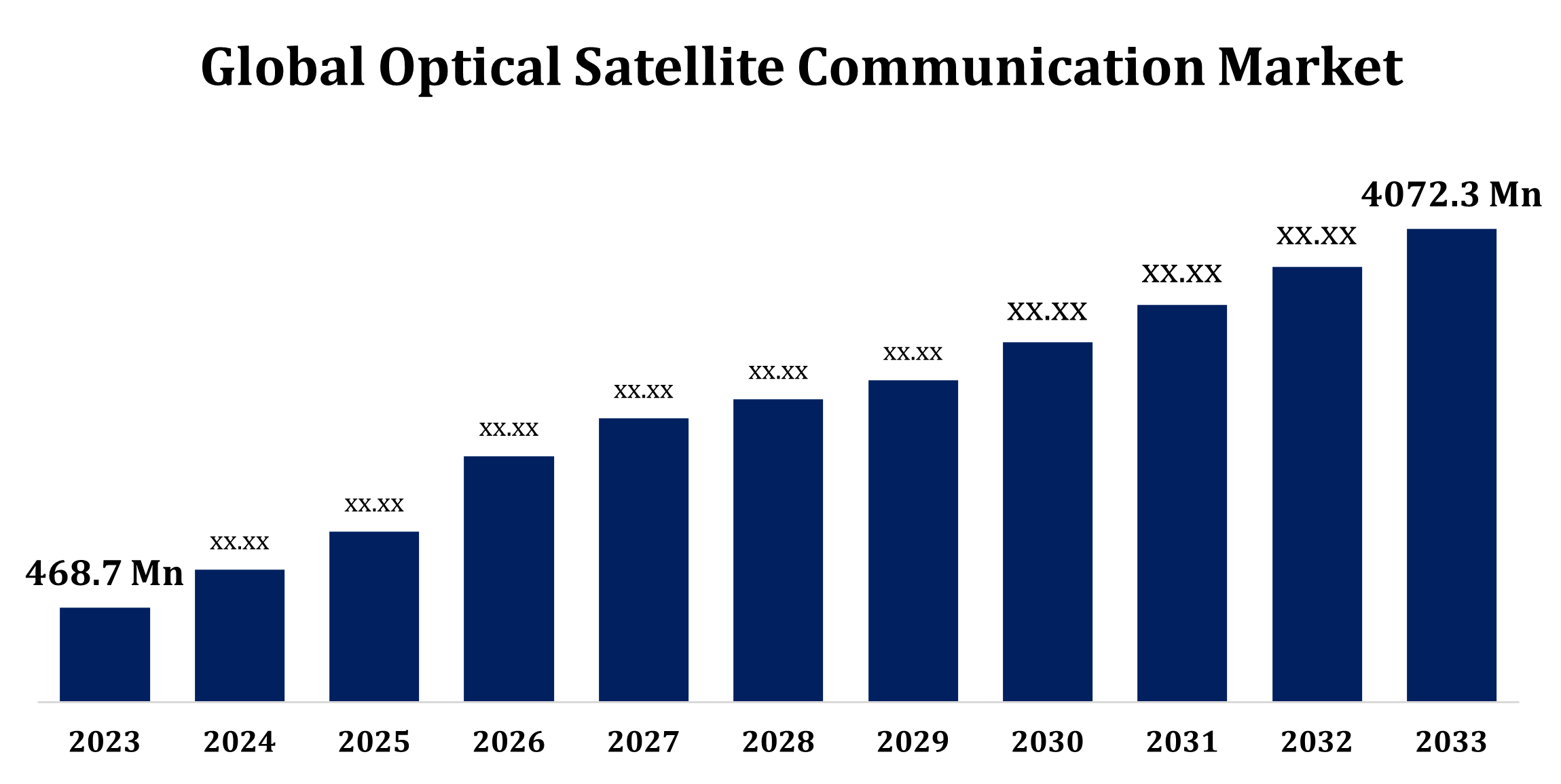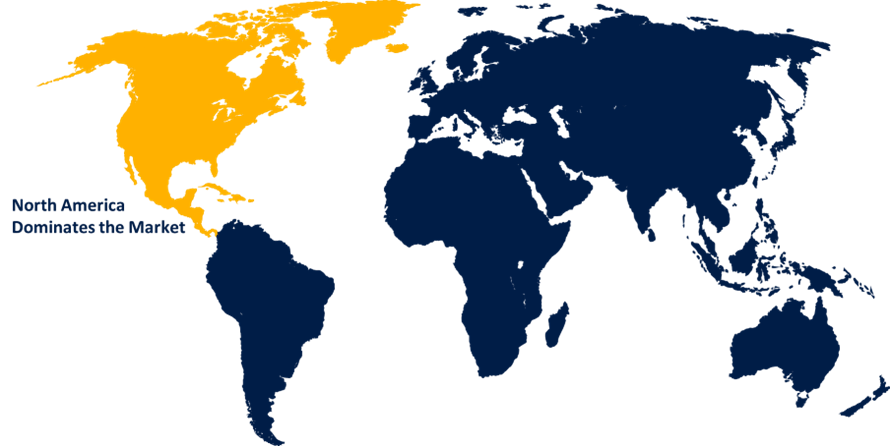Global Optical Satellite Communication Market Size To Worth USD 4,072.3 Million By 2033 | CAGR of 24.14%
Category: Aerospace & DefenseGlobal Optical Satellite Communication Market Size To Worth USD 4,072.3 Million By 2033
According to a research report published by Spherical Insights & Consulting, the Global Optical Satellite Communication Market Size to grow from USD 468.7 Million in 2023 to USD 4,072.3 Million by 2033, at a Compound Annual Growth Rate (CAGR) of 24.14% during the forecast period.

Get more details on this report -
Browse key industry insights spread across 246 pages with 98 Market data tables and figures & charts from the report on the "Global Optical Satellite Communication Market Size, Share, and COVID-19 Impact Analysis, By Component (Transmitter, Receiver), By Application (Backhaul, Earth Observation), and By Region (North America, Europe, Asia-Pacific, Latin America, Middle East, and Africa), Analysis and Forecast 2023 - 2033." Get Detailed Report Description Here: https://www.sphericalinsights.com/reports/optical-satellite-communication-market
The optical satellite communication market is experiencing rapid growth, driven by the rising demand for high-speed, secure, and dependable communication systems. Utilizing laser technology for data transmission, optical satellite communication provides benefits such as higher bandwidth, minimal signal interference, and lower latency compared to conventional radio frequency systems. Key drivers include advancements in satellite technology, the expansion of low-earth orbit (LEO) satellites, and increasing demand from industries like defense, aerospace, and telecommunications. Both governments and private entities are investing significantly in developing optical ground stations and inter-satellite links to improve global connectivity. However, challenges such as high deployment costs, atmospheric interference, and the need for precise alignment remain. Continued innovation and collaboration are expected to overcome these challenges, ensuring sustained market growth in the future.
Optical Satellite Communication Market Value Chain Analysis
The value chain of the optical satellite communication market encompasses several stages, from component production to end-user delivery. It starts with component suppliers, who provide essential elements such as lasers, photodetectors, and optical transceivers. Satellite manufacturers then integrate these components into optical communication systems. Ground station developers play a vital role in establishing infrastructure for data transmission and reception. Service providers leverage these systems to deliver communication services to industries including defense, aerospace, telecommunications, and commercial sectors. Regulatory bodies ensure market compliance with international standards. Research and development efforts throughout the value chain focus on enhancing technology efficiency, lowering costs, and overcoming challenges like atmospheric interference. Collaboration among stakeholders fosters innovation, making the value chain dynamic and interconnected.
Optical Satellite Communication Market Opportunity Analysis
The optical satellite communication market offers substantial growth opportunities, driven by the rising demand for high-speed, secure data transmission. The expansion of low-earth orbit (LEO) satellites and advancements in laser communication technologies present opportunities for improved global connectivity and reduced latency. New applications in 5G backhaul, autonomous vehicles, and maritime communications further broaden the market’s potential. The defense and aerospace sectors are increasingly adopting optical satellite communication for secure, interference-free data transfer. Additional opportunities arise from integrating optical communication with quantum technologies, which could lead to breakthroughs in cybersecurity. The development of optical ground stations and inter-satellite links also represents a growth area. However, overcoming challenges like high deployment costs and atmospheric interference through innovative solutions will be essential to fully realize the market’s potential.
The increasing number of mobile phone users worldwide is a key factor driving growth in the optical satellite communication market. As demand for mobile connectivity rises, traditional communication infrastructures struggle to provide seamless, high-speed data services, especially in remote or underserved areas. Optical satellite communication offers a practical solution, utilizing laser-based systems to deliver greater bandwidth, lower latency, and secure data transmission. This technology is essential for supporting the rapid expansion of mobile networks, including the rollout of 5G and future technologies. Additionally, the growing adoption of smartphones and data-heavy applications like video streaming and cloud services further fuels demand for reliable satellite communication systems. By bridging coverage gaps and enabling high-performance connectivity, optical satellite communication is crucial in meeting the increasing needs of mobile phone users worldwide.
High deployment costs pose a significant challenge, as the advanced laser systems and required infrastructure involve substantial financial investment. Atmospheric conditions such as clouds, rain, and turbulence can interfere with signal quality, reducing system reliability during unfavorable weather. The need for accurate alignment between satellites and ground stations introduces operational complexity, requiring advanced tracking and pointing mechanisms. Regulatory issues, including spectrum allocation and adherence to international standards, further complicate the market's growth. Limited awareness and adoption, particularly in developing regions, hinder market penetration. Moreover, the technology’s reliance on continuous innovation to solve challenges related to latency, power consumption, and scalability highlights the ongoing need for research and development. Addressing these obstacles is crucial for ensuring the long-term expansion of the market.
Insights by Component
The Transmitter segment accounted for the largest market share over the forecast period 2023 to 2033. Optical transmitters, which utilize lasers to transmit data over long distances, provide benefits such as higher bandwidth, lower latency, and reduced interference compared to traditional radio frequency systems. These advantages are particularly crucial for applications like 5G backhaul, defense communications, and space exploration, where data integrity and speed are essential. The increasing adoption of low-earth orbit (LEO) satellites, which rely on advanced transmitters for inter-satellite communication, is also driving demand in the market. Furthermore, innovations in optical technology, such as more compact and efficient laser systems, are improving performance and lowering costs, further boosting the growth of the transmitter segment. This trend is expected to persist as industries increasingly adopt optical satellite communication solutions.
Insights by Application
The Earth Observation segment accounted for the largest market share over the forecast period 2023 to 2033. Optical satellite communication offers high bandwidth and low latency, making it well-suited for the rapid and secure transmission of large amounts of Earth observation data. As the need for precise, real-time information on climate change, deforestation, urbanization, and natural disasters increases, optical communication systems allow for more efficient data transfer from satellites to ground stations. The expansion of low-earth orbit (LEO) satellite constellations further boosts Earth observation capabilities by ensuring continuous global coverage. As governments, research organizations, and private enterprises invest in Earth observation technologies, the demand for dependable, high-performance optical communication solutions is expected to rise steadily.
Insights by Region

Get more details on this report -
North America is anticipated to dominate the Optical Satellite Communication Market from 2023 to 2033. The region benefits from the presence of key players in satellite manufacturing, telecommunications, and defense, which drive innovation in optical communication technologies. High demand for secure, high-speed data transmission across sectors such as aerospace, military, and commercial telecommunications further accelerates market growth. The U.S. government’s initiatives, including collaborations with private space companies and funding for research and development, strengthen the market’s potential. Additionally, the deployment of low-earth orbit (LEO) satellite constellations and optical ground stations enhances the region’s ability to provide seamless connectivity. Supportive regulatory frameworks and a focus on integrating emerging technologies ensure North America remains a dominant force in this market.
Asia Pacific is witnessing the fastest market growth between 2023 to 2033. China and India are playing key roles, with government initiatives and private sector partnerships driving advancements in space capabilities and satellite deployments. The growth of low-earth orbit (LEO) satellite constellations and progress in laser communication technologies further contribute to market expansion. Industries such as defense, telecommunications, and maritime are increasingly adopting optical communication to overcome connectivity challenges in remote areas. However, the region faces obstacles, including high deployment costs and the need for sophisticated infrastructure. Ongoing innovation and supportive government policies are expected to strengthen Asia-Pacific’s position as a major player in the global market.
Recent Market Developments
- In 2021, NASA, the U.S.-based space agency, has introduced its new Laser Communications Relay Demonstration (LCRD) system. This system will help the agency advance optical communication technologies in space.
Major players in the market
- ATLAS Space Operations, Inc.
- Analytical Space Inc.
- Hisdesat Servicios Estrategicos S.A.
- BridgeSat Inc.
- Mitsubishi Electric Corporation
- Maxar Technologies Ltd.
- SITAEL S.p.A
- Mynaric AG
- Laser Light Communications Inc.
Market Segmentation
This study forecasts revenue at global, regional, and country levels from 2023 to 2033.
Optical Satellite Communication Market, Component Analysis
- Transmitter
- Receiver
Optical Satellite Communication Market, Application Analysis
- Backhaul
- Earth Observation
Optical Satellite Communication Market, Regional Analysis
- North America
- US
- Canada
- Mexico
- Europe
- Germany
- Uk
- France
- Italy
- Spain
- Russia
- Rest of Europe
- Asia Pacific
- China
- Japan
- India
- South Korea
- Australia
- Rest of Asia Pacific
- South America
- Brazil
- Argentina
- Rest of South America
- Middle East & Africa
- UAE
- Saudi Arabia
- Qatar
- South Africa
- Rest of the Middle East & Africa
About the Spherical Insights & Consulting
Spherical Insights & Consulting is a market research and consulting firm which provides actionable market research study, quantitative forecasting and trends analysis provides forward-looking insight especially designed for decision makers and aids ROI.
Which is catering to different industry such as financial sectors, industrial sectors, government organizations, universities, non-profits and corporations. The company's mission is to work with businesses to achieve business objectives and maintain strategic improvements.
CONTACT US:
For More Information on Your Target Market, Please Contact Us Below:
Phone: +1 303 800 4326 (the U.S.)
Phone: +91 90289 24100 (APAC)
Email: inquiry@sphericalinsights.com, sales@sphericalinsights.com
Contact Us: https://www.sphericalinsights.com/contact-us
Need help to buy this report?